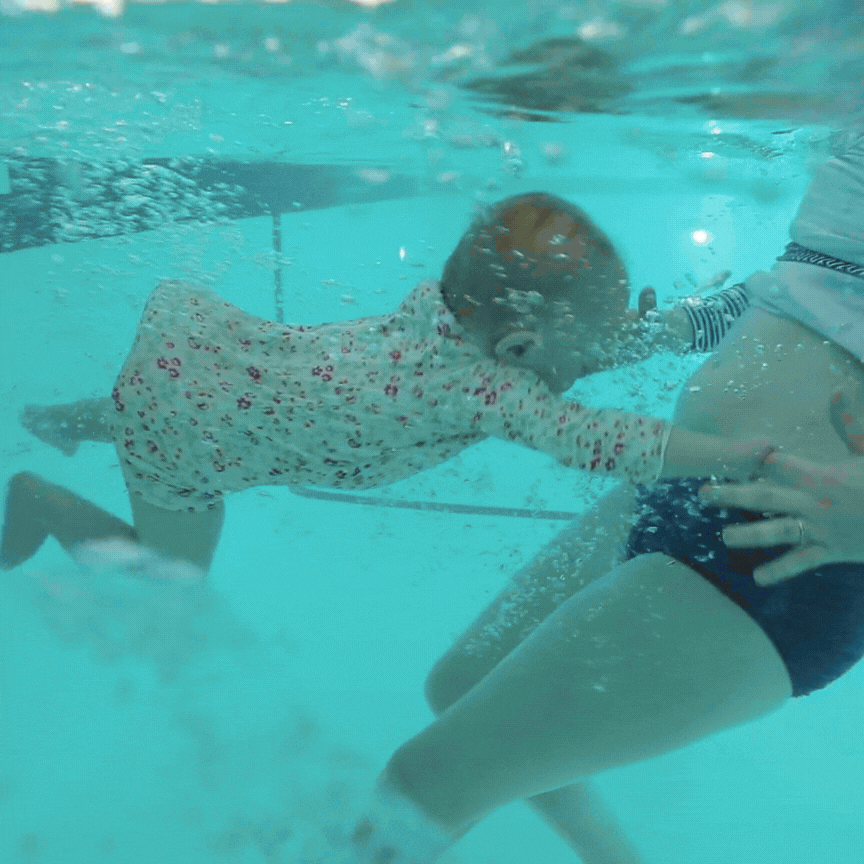Let’s Talk About Submerging Babies Underwater
One of the most important skills a child can learn in the water is how to go under safely. Submersions are more than just putting a baby underwater—they’re about teaching breath control, resilience, and confidence that could one day save their life.
If your child ever falls into the water and you don’t know how to help them, the experience can be ten times worse—for both you and your child. Not only is the moment frightening, but it can also cause your child to regress in their water comfort and confidence (read more about navigating regressions here).
So, ask yourself:
Would you rather not have control of the situation and risk your child’s first experience underwater being panic and fear?
Or would you rather teach them how to handle submersion in a calm, gradual way—so when they do come up, you’re the safe, reassuring face they see first?
We believe submersions are about preparing children, not scaring them. Our goal is always that a child is entering and exiting the water intentionally—with awareness, breath control, and skills that build lifelong safety.
Why Submersions Matter
They prepare for real-life falls. Accidents happen—even to the most cautious families. Practicing submersions helps a child know what to do if they fall in. Instead of panicking, they’ve already learned how to hold their breath and stay calm.
They teach respect for water. The water is powerful. Kids who learn calm submersions gain respect for its strength while also learning they can move with it, not fight against it.
They build resilience. Everyone coughs. Everyone swallows water. Everyone gets startled sometimes. What matters is recovery. Teaching your child that discomfort passes and that they can try again is one of the most valuable life lessons you can give them.
They create trust between parent and child. Each submersion is a moment of communication—you cue, they respond, and you guide them safely through. Over time, your child learns: “I can do hard things because my parent stays calm and helps me.”
What Submersions Actually Look Like
When people hear “submersion,” they sometimes picture a child being “dunked.” That’s not what we do at Watermellow. Our submersion routines are structured, gentle, and progressive. Each step is designed to keep your child secure, build comfort gradually, and develop strong breath control.
Here’s how it works:
1. Cup Submersions
The first introduction to water on the face.
Body Position: Parent holds baby in a secure Lap, Hip, or T-Shirt Hold, staying close with steady eye contact.
Breath Control: Parent models breathing—inhale, hold, exhale—and cues baby with “Take a breath.” Then gently pour water over the baby’s forehead for up to 3 seconds.
Goal: Baby stays calm while experiencing full head water coverage. Parent supports recovery by encouraging mouth breathing and offering praise.
2. Assisted Submersions
Once cup pours are comfortable, we move to brief assisted underwater experiences.
Body Position: Parent holds baby in a Towards, Side, or Standing Hold with a secure but gentle grip.
Breath Control: Parent cues and models “Take a breath.” On the lift, baby inhales. On the quick, gentle lower, baby holds their breath as the face enters the water at a slight downward angle.
Goal: Baby stays submerged calmly for up to 3 seconds, exhales after surfacing, and avoids panic movements. Parent may add gentle forward motion, letting baby naturally kick or move arms.
3. Assisted Pancake Flips
After mastering assisted submersions, babies learn to transition from front to back or back to front in the water.
Breath Control: Baby practices holding their breath underwater, then flips smoothly to a back float.
Goal: This prepares them to handle unexpected water entries, teaching both submersion and recovery skills.
Staying Calm: The Parent’s Role
The single most important part of submersion training is your calm energy. Babies feed off your reactions. If you smile, breathe steadily, and show confidence, they are more likely to do the same.
Here are a few reminders for parents:
Model the routine every time: deep inhale, calm hold, gentle submersion, calm exhale.
Avoid sudden or jerky movements—smoothness helps your child feel secure.
If your child coughs or swallows water, don’t panic. Offer comfort, let them recover, and then praise them for trying.
Remember: the goal is not “perfect” breath holding. The goal is gradual progress, resilience, and comfort.
Debunking Common Myths About Submersion
“Water in the ears is unsafe.”
Totally safe! Baby ears are designed to handle water. Just dry the outer ear with a towel afterward. Read more here.
“Dry drowning can happen hours later.”
This is a widespread myth. True “dry drowning” is extremely rare and only follows a drowning incident. Real prevention comes from teaching water comfort and skills early. Read more here.
“Babies can’t learn to hold their breath.”
They can! Babies are born with a natural reflex to hold their breath underwater. With consistent, gentle practice, they learn to control it intentionally. Read more here.
“Swallowing water is dangerous.”
A little water swallowed during practice is normal and usually harmless. The key is keeping calm so your child learns not to fear it. Read more here.
“Infants are too young for swim lessons.”
Actually, the earlier the better. Even bath-time submersions build comfort and confidence that pay off later in formal lessons. Read more here.
The Big Picture
Submersions aren’t about pushing children to their limits or “toughening them up.” They’re about teaching safety, recovery, and confidence—skills that could one day save their life.
Every time your child goes under and comes back up calmly, they’re learning:
✔️ How to respect the water
✔️ How to manage their breath
✔️ How to recover from discomfort
✔️ How to trust themselves and you
When children learn to intentionally put themselves in and out of the water, they aren’t just “practicing swimming.” They’re gaining a foundation for lifelong safety, resilience, and confidence.





















